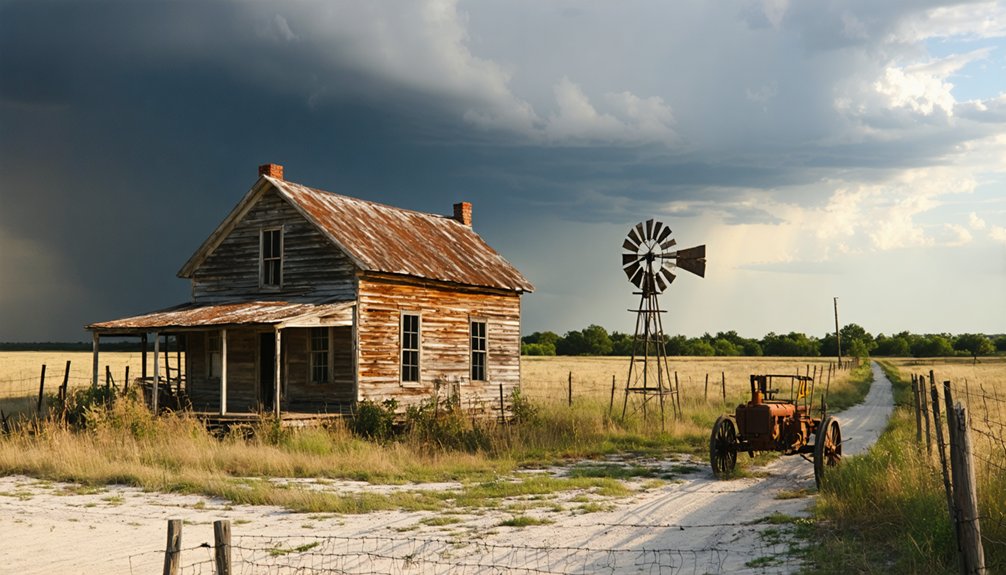You’ll discover Bomarton nestled in Baylor County, Texas, where the Wichita Valley Railroad once brought life to this agricultural boomtown in 1906. St. John’s Catholic Church, built by Czech settlers, still stands as a monument to the town’s peak population of 600 residents. Today, you’ll find abandoned buildings, including the historic schoolhouse and cemetery, telling stories of a thriving community that faded into ghost town status after World War II. The church’s creaky floors and deteriorating bell tower hold secrets waiting to be uncovered.
Key Takeaways
- Bomarton is a Texas ghost town established in 1906 along the Wichita Valley Railroad, reaching a peak population of 600 residents.
- St. John’s Catholic Church, built in 1908, remains standing with intact altar and stained glass windows, attracting ghost hunters and history enthusiasts.
- The town’s decline began post-World War II due to railroad obsolescence and agricultural mechanization, with population dropping to 150 by 1960.
- Notable landmarks include an abandoned schoolhouse with original skating rink and a cemetery with ornate gravestones of early settlers.
- The ghost town welcomes visitors, with St. John’s Catholic Church maintained as a private museum documenting Czech settler heritage.
The Rise of a Texas Railroad Town
As Texas emerged from its frontier days in the mid-19th century, the arrival of railroads transformed the state’s landscape and gave birth to numerous towns along the expanding rail lines.
You’d have witnessed the railroad’s significance firsthand in places like Bomarton, where steel tracks brought the promise of prosperity and connection to the wider world.
Just like many Texas towns of that era, Bomarton’s destiny was tied to the economic transformation that railroads delivered.
Railroads shaped the fate of countless Texas towns, carrying the seeds of progress through once-empty prairies and forgotten crossroads.
You could’ve seen how these iron horses changed everything – bringing jobs, attracting diverse workers, and turning isolated outposts into bustling communities.
The railways didn’t just move goods and people; they created the essential infrastructure that determined whether a town would thrive or fade into obscurity in the vast Texas territory.
Following the path of towns like Wharton, which saw its first railway with the NYT&M Railway in 1881, these rail connections became lifelines for agricultural communities.
By 1900, the state had built nearly 10,000 miles of track, setting the stage for unprecedented growth in towns like Bomarton.
Early Settlers and Community Development
The story of Bomarton began with W. H. Bomar, a pioneer whose name would mark this slice of Texas history. In 1906, when Tom McClure opened the first post office, you’d have witnessed the birth of a true frontier community. The settler motivations were clear – fertile farmland and the promise of prosperity brought by the newly constructed Wichita Valley Railroad.
You would’ve found a tight-knit community of Czech immigrants, mostly Catholic, establishing their roots in this promising land. Community cohesion flourished as B. B. Calfee and J. R. Snyder opened businesses, while a schoolhouse served double duty as both classroom and church. Like the dance pavilion in Taiton, these gathering places fostered social connections among the early residents. The local faithful would gather at their wooden church building, constructed in the same year the town was established.
A baseball team and local band emerged, painting a picture of vibrant social life. These early settlers transformed raw prairie into a thriving agricultural hub, connected to broader markets by steel rails.
St. John’s Catholic Church Legacy
Standing as a tribute to Bomarton’s religious heritage, St. John’s Catholic Church first emerged in 1908 when Czech settlers gathered for services in Mary’s Creek Schoolhouse.
You’ll find the church’s evolution reflected in its architecture, evolving from a modest wooden structure to an impressive brick building in the late 1930s.
As the “Mother Church” for Czech Catholics in northwest Texas, St. John’s fostered vibrant community traditions.
Bishop J.P. Lynch led a historic dedication ceremony in 1914 with sixty children receiving confirmation that day.
The church served a peak community of 580 residents during its most prosperous years in 1920.
You could’ve witnessed elaborate Corpus Christi celebrations with outdoor altars, processions, and festive gatherings.
Under Father Paul Mosler’s leadership from 1910, the parish flourished with thousands of baptisms, weddings, and communal events.
Today, though abandoned with a crumbling bell tower, this ghost town relic still tells the story of Bomarton’s once-thriving Catholic community.
Population Boom and Economic Growth
Drawn by fertile soil and promising rail connections, settlers began transforming Bomarton from a modest outpost into a bustling agricultural hub in the late 19th century.
You’d have seen cotton fields stretching across the horizon and cattle grazing on vast ranches, while merchants set up shops to serve the growing population.
The town’s demographic trends reflected the diverse fabric of Wharton County, with Hispanic, African American, and White residents working side by side. Early historical records required careful disambiguation of names to accurately track the town’s population growth due to similar spellings of nearby settlements. The county’s overall population showed minimal growth patterns, increasing just 1.3% between 2010 and 2022.
As U.S. Highway 59 carved through the region, Bomarton’s economy flourished. Local businesses thrived, from equipment dealers to livestock markets, supporting thousands of residents during the peak years.
However, economic shifts in the latter half of the 20th century would challenge this prosperity, marking the beginning of significant changes for this once-vibrant community.
Post-War Decline and Abandonment
While Bomarton thrived during the pre-war years with a population of 600 residents, the post-World War II era marked a devastating decline for this once-vibrant community.
Today, only St. John’s Catholic Church remains as a silent reminder of the town’s past.
The Catholic church building was constructed in the 1930s and still welcomes respectful visitors and worshippers.
You’ll find the dramatic economic shifts that transformed this Texas town reflected in its rapid demographic changes, as the population plummeted to just 150 by 1960.
The town’s decline was driven by four key factors:
- The diminishing importance of the Wichita Valley Railroad
- Agricultural mechanization that eliminated local farm jobs
- Closure of crucial businesses like stores and cotton gins
- Migration of younger generations to urban areas
Cultural Heritage and Czech Influence
Despite its eventual decline, Bomarton’s cultural landscape was profoundly shaped by Czech immigrants who settled in the region following the European revolutions of 1848.
You’ll find that these settlers, inspired by Rev. Josef Arnost Bergmann‘s letters describing Texas opportunities, brought their rich heritage to the area while seeking freedom from European feudal constraints.
The Czech traditions they maintained centered around their Catholic faith, with Saints Cyril and Methodius Catholic Church becoming the heart of community life.
Cultural festivals and religious celebrations kept their customs alive, while organizations like the KJT (Czech Catholic Union of Texas) strengthened community bonds.
Though Bomarton itself faded, the surrounding region’s Czech influence endures through the Texas Czech Heritage and Cultural Center in nearby La Grange, preserving the legacy of these freedom-seeking pioneers.
Modern Ghost Town Landmarks

Today’s visitors to Bomarton will find five notable landmarks that tell the story of this once-thriving community. As you explore these architectural remnants, you’ll discover St. John’s Catholic Church with its deteriorating bell tower, the adjacent cemetery filled with ornate tombstones, and the abandoned schoolhouse that once hosted lively community gatherings.
- The church’s creaky floors and accessible steeple create opportunities for ghostly encounters.
- Weathered gravestones reveal fascinating personal histories of early settlers.
- The schoolhouse’s gymnasium, complete with its original skating rink, stands frozen in time.
- Scattered residential structures showcase typical rural Texas architecture from the early 1900s.
These silent sentinels serve as powerful reminders of Bomarton’s evolution from a bustling town of 600 to today’s quiet ghost town with fewer than 15 residents.
Historical Sites and Preservation
Since its establishment alongside the Wichita Valley Railroad in 1906, Bomarton’s historical sites have stood as enduring monuments to early 20th-century Texas life.
You’ll find St. John’s Catholic Church, rebuilt in brick during 1936, still standing with its damaged windows and crumbling bell tower – now privately maintained as a museum welcoming respectful visitors.
Historic preservation efforts continue through local engagement, with descendants and community members protecting these cherished landmarks.
Local families and residents work tirelessly to safeguard Bomarton’s historic treasures, preserving their heritage for future generations.
While the church’s pews are gone, its altar and stained glass windows remain intact, drawing ghost hunters and history enthusiasts who document their visits in an on-site guest book.
The Old Bomarton Schoolhouse, complete with its nostalgic skating rink, serves as another symbol of the town’s vibrant past, though its population has dwindled to nearly nothing since 2000.
Frequently Asked Questions
Are There Any Dangerous Animals or Wildlife in the Abandoned Town?
You’ll need to watch for rattlesnakes, coyotes, and wild hogs during wildlife encounters. Keep your distance from abandoned buildings where scorpions and black widows lurk. Take safety precautions seriously.
Can Visitors Legally Explore and Photograph the Abandoned Buildings?
Walking a legal tightrope, you’ll need landowner permission for urban exploration since most structures are privately owned. You can freely photograph from public roads, but don’t enter buildings without explicit approval.
What Happened to the Original Church Bell From St. John’s?
You’ll find no definitive records of the church bell’s fate, though its historical significance as a community timekeeper vanished along with the bell itself from St. John’s crumbling tower.
Do Any Descendants of Original Bomarton Families Still Live Nearby?
You’ll find some descendants in surrounding Baylor County, though they’re not well documented. Family history suggests original families dispersed regionally, with local connections maintained through occasional cemetery visits and heritage sites.
Has the Town Ever Been Used as a Movie Filming Location?
You won’t find any documented movie history or filming locations here – despite its haunting appeal, there’s no evidence that production companies have ever used this remote spot for shooting films.
References
- https://en.wikipedia.org/wiki/Bomarton
- https://texashighways.com/travel-news/ghost-hunting-at-the-abandoned-bomarton-church/
- https://www.youtube.com/watch?v=WxQ3KEFChvo
- https://kids.kiddle.co/Bomarton
- https://daytrippintexas.com/north-texas/abandoned-st-johns-catholic-church-bomarton/
- https://www.youtube.com/watch?v=NdZOFY-u2AQ
- https://stevenmaier.com/ghost-town-bomarton-tx/
- https://www.texasescapes.com/TexasTowns/Bomarton-Texas.htm
- https://www.tshaonline.org/handbook/entries/railroads
- http://www.tsl.texas.gov/exhibits/railroad/beginnings/page2.html



